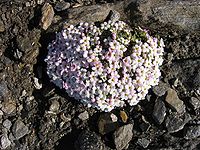
Photo from wikipedia
Abstract Temperate mountain ranges such as the European Alps have been strongly affected by the Pleistocene glaciations. Glacial advances forced biota into refugia, which were situated either at the periphery… Click to show full abstract
Abstract Temperate mountain ranges such as the European Alps have been strongly affected by the Pleistocene glaciations. Glacial advances forced biota into refugia, which were situated either at the periphery of mountain ranges or in their interior. Whereas in the Alps peripheral refugia have been repeatedly and congruently identified, support for the latter scenario, termed “nunatak hypothesis,” is still limited and no general pattern is recognizable yet. Here, we test the hypothesis of nunatak survival for species growing in the high alpine to subnival zones on siliceous substrate using the cushion plant Androsace alpina (Primulaceae), endemic to the European Alps, as our model species. To this end, we analyzed AFLP and plastid DNA sequence data obtained from a dense and range‐wide sampling. Both AFLPs and plastid sequence data identified the southwestern‐most population as the most divergent one. AFLP data did not allow for discrimination of interior and peripheral populations, but rather identified two to three longitudinally separated major gene pools. In contrast, in the eastern half of the Alps several plastid haplotypes of regional or local distribution in interior ranges—the Alpine periphery mostly harbored a widespread haplotype—were indicative for the presence of interior refugia. Together with evidence from other Alpine plant species, this study shows that in the eastern Alps silicicolous species of open habitats in the alpine and subnival zone survived, also or exclusively so, in interior refugia. As the corresponding genetic structure may be lost in mostly nuclear‐derived, rapidly homogenizing marker systems such as AFLPs or RAD sequencing tags, markers not prone to homogenization, as is the case for plastid sequences (Sanger‐sequenced or extracted from an NGS data set) will continue to be important for detecting older, biogeographically relevant patterns.
Journal Title: Ecology and Evolution
Year Published: 2019
Link to full text (if available)
Share on Social Media: Sign Up to like & get
recommendations!